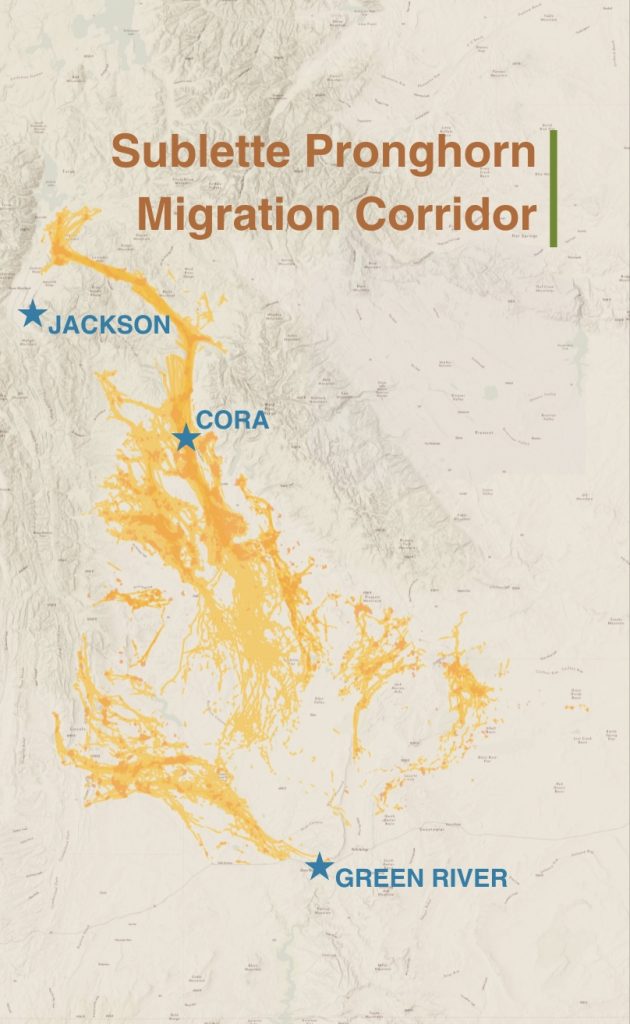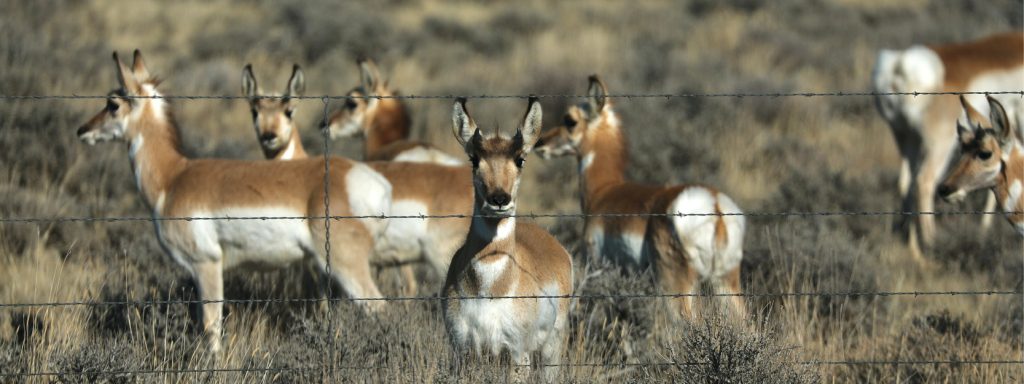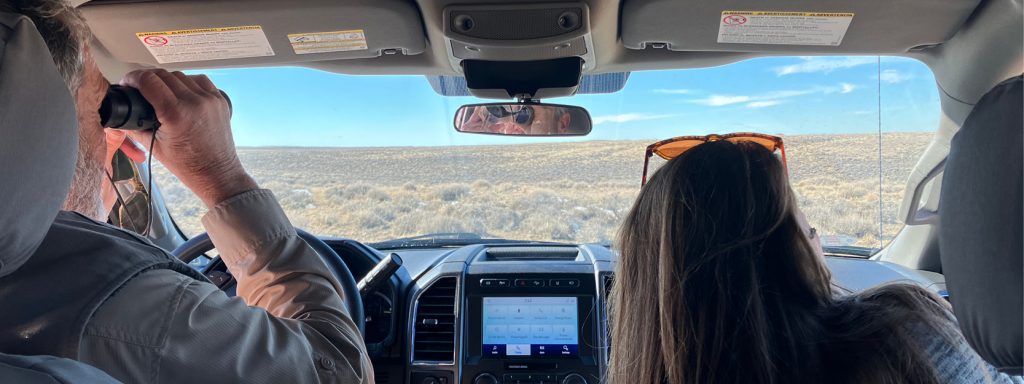A conversation with Bill Ames, longtime Green River resident, about coexisting with migrating pronghorn
Twice a year, Sublette Pronghorn embark on one of the longest land migrations in the lower 48 states — an epic journey stretching 165 miles from I-80 to Grand Teton National Park. Their ancient migration pathways crisscross highways and meander through ranches, communities, and the backyards of people who call this part of Wyoming home.
Bill Ames of Green River is one such person. Bill moved to Green River more than 40 years ago for a land surveyor role, and his career and hunting interests have made him a keen observer of the land and the critters that call it home, including the Sublette Pronghorn herd.
As a part of our series on people connected to this magnificent migration, Bill was kind enough to share his story with us during a trip outside of town in search of pronghorn on their winter range.
We hopped into Bill’s truck and drove up Highway 372 onto the sagebrush plateau. Sure enough — near a large solar project, trona mine, and numerous gravel pits — we encountered several bands of wary pronghorn that moved away swiftly as the truck’s tires ground to a stop.
This interview has been edited for clarity and brevity.


WOC: Can you share a bit about your background, and what you love about this area?
Bill: I was a land surveyor by trade, and I worked mostly pipelines and power lines. I was in the desert all the time, and had boots on the ground most days of the year. I was exposed to the vastness, the public access, and the diversity of wildlife constantly. Before moving, I had no idea something like this existed. I was like a kid at Christmas when I found out [about the West].
WOC: Why is this area relevant to the Sublette pronghorn herd?
Bill: We’re standing along Highway 372, and it’s a migration corridor for antelope. We’re real close to the solar project that was on Highway 372, and there are a lot of gravel pits right around here. There is a lot of industrial activity and the habitat has changed. The antelope keep coming because this is what they know. This is home. Other than the highway mortality — which we’ve seen quite a bit of since I’ve been here — I really haven’t seen a lot of winter mortality up on this plateau that Highway 372 runs down. It’s a pretty good spot for the critters to make a living.
WOC: What changes have you seen over the course of your life here watching pronghorn antelope in this area and interacting with them?
Bill: We don’t have quite as many antelope as we did when I moved here. You can tell they’re seasonal critters. I mean, there are antelope that live here all year round, but there are definitely more antelope that show up here in the winter time.
WOC: What are some of the specific ways you’ve noticed people enjoy wildlife on the landscape?
Bill: Antelope are easily accessed, readily available, and you can go out and see them. You can see them with their fawns, and you can see them in the winter. The community as a whole — we just enjoy them.
In Green River, there [are fewer] deer and elk on the landscape — nothing like antelope. For the hunting public, hunting antelope is perfect for kids. It’s a great opportunity for them, and I just wish we had more on the landscape so they could draw a license a little easier.
WOC: What’s the value in protecting the Sublette Pronghorn migration corridor?
Bill: I don’t think we would have any antelope if we didn’t have the migrations. They have to follow the habitat. They have to follow the green-up — the vegetation for raising their fawns — and follow less-snowy habitat to make it through the winter. It takes miles. From the Teton Park down here to Rock Springs — there’s antelope that have been documented traveling 165 miles.
The mountain men trappers were here 1780 to 1830 — that’s only 200 years ago. The railroad came in 1866, and the barbed wire fence came in around 1880, and Wyoming wasn’t a state until 1890. That’s 135 years ago. That’s like yesterday. These antelope have been here for centuries before that with no man-made obstructions. When you look [at] what man has put on the landscape to make it more difficult for this wildlife, you ask “where are we going to be in 20, 40, 50 years?”
It’s never going to be easier to protect these migration corridors than right now, and I think industry can live with it. I know the people of Wyoming would support that. If we could just preserve some of these wildlife corridors so that future generations can enjoy what we’ve enjoyed, and allow these antelope to reach their full habitats as they’ve done for centuries. It is just something we can’t afford to lose. Once it’s gone, I don’t know if you could get it back.
It isn’t like you can put signs up telling the antelope where to go if they don’t know how to get there. The corridor is lost and we can’t afford to go down that path.
I know industry and oil and gas. It’s all money, but the value of wildlife and their corridors are only going to increase. [A corridor is very valuable today], but in 50 years, migration corridors are going to be so priceless. I would hope our future generations would be very appreciative of that. It’s worth a lot.
It’s never going to be easier to protect these migration corridors than right now, and I think industry can live with it. I know the people of Wyoming would support that … It is just something we can’t afford to lose. Once it’s gone, I don’t know if you could get it back.
— Bill Ames
WOC: What are your hopes for the future, when it comes to the ability of these animals to migrate?
Bill: I hope that we’re able to coexist with these migration corridors. We need industry, we need oil and gas, we need right-of-ways for power lines and pipelines, but you know, we can work together. My whole life was in the oil and gas industry, and technology has changed. We have the ability to horizontal drill if we have to, and we can preserve these migration patterns to allow the animals to get where they need to survive the year, prosper, and keep their populations up.
Still, man can develop the resources that it takes to maintain our lifestyles. It isn’t like these wildlife corridors are going to take up the whole country. It’s just a little sliver that they need to maintain their historic values. And I hope we can achieve that for them.
It’s just a little sliver that they need to maintain their historic values. And I hope we can achieve that for them.
— Bill Ames
WOC: You’ve done amazing work to preserve these corridors yourself, by getting out onto the landscape and installing gates of your own creation. What has that process looked like and where have you drawn inspiration?
Bill: Working in oil and gas from Baggs to Pinedale to Big Piney to Evanston, I saw the struggles wildlife have with fences. Fences are necessary, [especially in the agricultural industry], but are there smarter ways we can do it? Can we get these animals to cross these fences without burning a lot of extra calories pacing up and down?
I felt fences were one of the main issues in wildlife’s struggle trying to make it through a year. ‘Drop-down fences’ with drop-down wires exist — and those are fantastic, but they’re a little labor-intensive. So I worked with the agricultural producers, and I tried to create a structure that would be acceptable to them that they could operate and have installed in their fences without much time to allow critters to cross more easily.
I came up with a pipe design for a fence that allows an 18-inch crossing underneath, and a 27-inch-high crossbar for them to get across in the winter time, when the gate is open. We’ve installed about 20 of them so far, and this year we’re going to get a lot more installed. Hopefully we can get the volunteers to come help.

From Green River to Cora to Jackson, our Pronghorn & People series features the stories of folks who share their backyards with migrating Sublette Pronghorn — and who are hopeful this migration receives the protection it needs to endure.
Keep an eye on our blog for more. In the meantime, learn more about this migration corridor and how you can help protect these incredible animals on our Sublette Pronghorn page.


These migration routes are important! Thank you for working to protect these areas for the future of wildlife.
Bill is right we defiantly need these migration corridors. Hopefully everyone can work together to maintain them. I have lived in Green River since 1965. The herds took a beating from the winter a few years back but with the proper management they will come back.